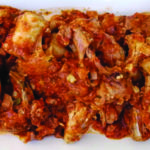MARCHIGIANA RABBIT STEW

This rabbit stew (the rabbit can be substituted with chicken) is a vintage dish. I found it in a 1970s collection of recipes from an elementary school project in Pergola. Each child was asked to bring one of their grandmother’s recipes to school to assemble a traditional regional cookbook.
Pergola is a tiny hillside village in the heart of the Marche region, a beautiful area that is unfortunately or fortunately out of the tourist mainstream, where a local first-class cuisine still thrives.
In an age where there was no intensive livestock farming in Italy, we followed the seasons for meat consumption so, the end of summer was the best moment to eat rabbit, since those born during the spring had fully grown.
Toss the wonderful fresh home-made noodles with the stew’s sauce in a bowl adding a few tablespoons of the pasta cooking water.
Prep Time: 30 minutes | Cooking Time: 90 minutes | Total Time: 2 hours | Yield: Makes 8-10 servings.
Ingredients
- 2 rabbits, chopped into small pieces
- 2 cans of tomato purée
- 2 onions, finely minced
- 2 carrots, finely minced
- 1 celery stalk, finely minced
- Rabbit liver, finely chopped
- 1 tbsp parsley, finely minced
- 2 slices pancetta or prosciutto, finely chopped
- ½ cup (125 ml) olive oil
- 3 cups (750 ml) water
- Salt and pepper
- Fresh tagliatelle (noodles) 800 grams
Instructions
Place the rabbit pieces in a non-stick saucepan and sauté them until their water content evaporates, about 15 to 20 minutes.
When they are cooked, add all the other ingredients except for the water and tomato, and sauté for 25 to 30 minutes at medium-low heat. Season with salt and pepper and when the vegetables and pancetta are browned, add the water and cook for an hour, then add the tomato and cook for 30 minutes.

